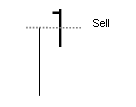R&D Blog
Bear Oops Pattern | Trading Strategy (Exits)
I. Trading Strategy
Developer: Larry Williams (Bear Oops Pattern). Concept: Gap failure. Research Goal: Performance verification of the Bear Oops Pattern with the ATR exit and time exit. Specification: Table 1. Results: Figure 1-2. Trade Setup: Short Trades: Open[Today] > High[Yesterday]. Trade Entry: Short Trades: A sell stop is placed at the level of High[Yesterday]. Trade Exit: Table 1. Portfolio: 42 futures markets from four major market sectors (commodities, currencies, interest rates, and equity indexes). Data: 32 years since 1980. Testing Platform: MATLAB®.
II. Sensitivity Test
All 3-D charts are followed by 2-D contour charts for Profit Factor, Sharpe Ratio, Ulcer Performance Index, CAGR, Maximum Drawdown, Percent Profitable Trades, and Avg. Win / Avg. Loss Ratio. The final picture shows sensitivity of Equity Curve.
Tested Variables: ATR_Index & Time_Index (Definitions: Table 1):
Figure 1 | Portfolio Performance (Inputs: Table 1; Commission & Slippage: $0).
| STRATEGY | SPECIFICATION | PARAMETERS |
| Auxiliary Variables: | N/A | |
| Setup: | Short Trades: Open[Today] > High[Yesterday]. | |
| Filter: | N/A | |
| Entry: | Short Trades: A sell stop is placed at the level of High[Yesterday]. | |
| Exit: | Time Exit: nth day at the close, n = Time_Index. ATR Exit: ATR(ATR_Length) is the Average True Range over a period of ATR_Length. ATR_Index is a multiple of ATR(ATR_Length). Short Trades: A buy stop is placed at [Entry + ATR(ATR_Length) * ATR_Index]. Stop Loss Exit: ATR(ATR_Length) is the Average True Range over a period of ATR_Length. ATR_Stop is a multiple of ATR(ATR_Length). Short Trades: A buy stop is placed at [Entry + ATR(ATR_Length) * ATR_Stop]. | Time_Index = [1, 40], Step = 1; ATR_Length = 20; ATR_Index = [1.0, 6.0], Step = 0.2; ATR_Stop = 6; |
| Sensitivity Test: | Time_Index = [1, 40], Step = 1 ATR_Index = [1.0, 6.0], Step = 0.2 | |
| Position Sizing: | Initial_Capital = $1,000,000 Fixed fractional = 1% Portfolio = 42 US Futures ATR_Stop = 6 (ATR ~ Average True Range) ATR_Length = 20 | |
| Data: | 42 futures markets; 32 years (1980/01/01−2011/12/31) |
Table 1 | Specification: Trading Strategy.
III. Sensitivity Test with Commission & Slippage
Tested Variables: ATR_Index & Time_Index (Definitions: Table 1):
Figure 2 | Portfolio Performance (Inputs: Table 1; Commission & Slippage: $50 Round Turn).
IV. Rating: Bear Oops Pattern | Trading Strategy
A/B/C/D
Related Entries: Oops Pattern (Exits) | Bull Oops Pattern (Exits)
Related Topics: (Public) Trading Strategies
CFTC RULE 4.41: HYPOTHETICAL OR SIMULATED PERFORMANCE RESULTS HAVE CERTAIN LIMITATIONS. UNLIKE AN ACTUAL PERFORMANCE RECORD, SIMULATED RESULTS DO NOT REPRESENT ACTUAL TRADING. ALSO, SINCE THE TRADES HAVE NOT BEEN EXECUTED, THE RESULTS MAY HAVE UNDER-OR-OVER COMPENSATED FOR THE IMPACT, IF ANY, OF CERTAIN MARKET FACTORS, SUCH AS LACK OF LIQUIDITY. SIMULATED TRADING PROGRAMS IN GENERAL ARE ALSO SUBJECT TO THE FACT THAT THEY ARE DESIGNED WITH THE BENEFIT OF HINDSIGHT. NO REPRESENTATION IS BEING MADE THAT ANY ACCOUNT WILL OR IS LIKELY TO ACHIEVE PROFIT OR LOSSES SIMILAR TO THOSE SHOWN.
RISK DISCLOSURE: U.S. GOVERNMENT REQUIRED DISCLAIMER | CFTC RULE 4.41
Codes: matlab/williams/bear-oops/





























